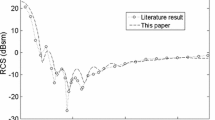Abstract
The finite-difference time-domain method based on recursive convoltion method (RC-FDTD) for the electric anisotropic dispersive medium is discussed in detail. To exemplify the availability of the three-dimensional RC-FDTD algorithm, the backscattering Radar-Cross-Section(RCS) of a non-magnetized plasma sphere is computed, and the numerical results are the same as the one of the Shift Operater-FDTD method, and show that the RC-FDTD method is correct and efficient. In addition, the co-polarized and cross-polarized backscattering time-domain of a magnetized plasma sphere are obtained by the RC-FDTD algorithm. The results show that when the external magnetic field is implemented, the cross-polarized component appear, evidently.



Similar content being viewed by others
References
R. J. Lubbers, F. Hunsberger, and K. S. Kunz, A frequency-dependent finite-difference time-domain formulation for transient propagation in plasma. IEEE Trans. Antennas Propag. 39(1), 29–34 (1991)
Y. Takayama, and W. Klaus, Reinterpretation of the auxiliary differential equation method for FDTD. IEEE Microw. Wirel. compon. Lett. 12(3), 102–104 (Mar. 1994)
D. M. Sullivan, Z-transform theory and the FDTD method. IEEE Trans. Antennas Propag. 44(1), 28–34 (Jan. 1996)
Q. Chen, M. Katsurai, and P. H. Aoyagi, A FDTD formulation for dispersive media using a current density. IEEE Trans. Antennas Propag. 46(11), 1739–1746 (Nov.1998)
D. B. GE, Y. L. WU, X. Q. ZHU, Shift operator method applied for dispersive medium in FDTD method (In Chinese). Chinese Journal of Radio Science 18(4), 359–362 (2003)
D. B. GE, and Y. B. YAN, Finite-Difference Time-Domain Method for Electromagnetic Waves (In Chinese). (Xidian University Press, Xi’an 2005).
L. J. Young, A full finite difference time domain implementation for radio wave propagation in a plasma. Radio Sci. 29, 1513–1522 (1994)
S. B. Liu, J. J. Mo, and N. C. Yuan, An auxiliary differential equation FDTD method for anisotropic magnetized plasmas. Acta Phys. Sin. (In Chinese) 53(7), 2233–2236 (2004)
F. Hunsberger, R. J. Lubbers, and K. S. Kunz, Finite-difference time-domain analysis of gyro tropic media-I: Magnetized plasma. IEEE Trans. Antennas Propag. 40(12), 1489–1495 (1992)
Author information
Authors and Affiliations
Corresponding author
Rights and permissions
About this article
Cite this article
Yang, L. 3D FDTD Implementation for Scattering of Electric Anisotropic Dispersive Medium Using Recursive Convolution Method. Int J Infrared Milli Waves 28, 557–565 (2007). https://doi.org/10.1007/s10762-007-9233-9
Received:
Accepted:
Published:
Issue Date:
DOI: https://doi.org/10.1007/s10762-007-9233-9



